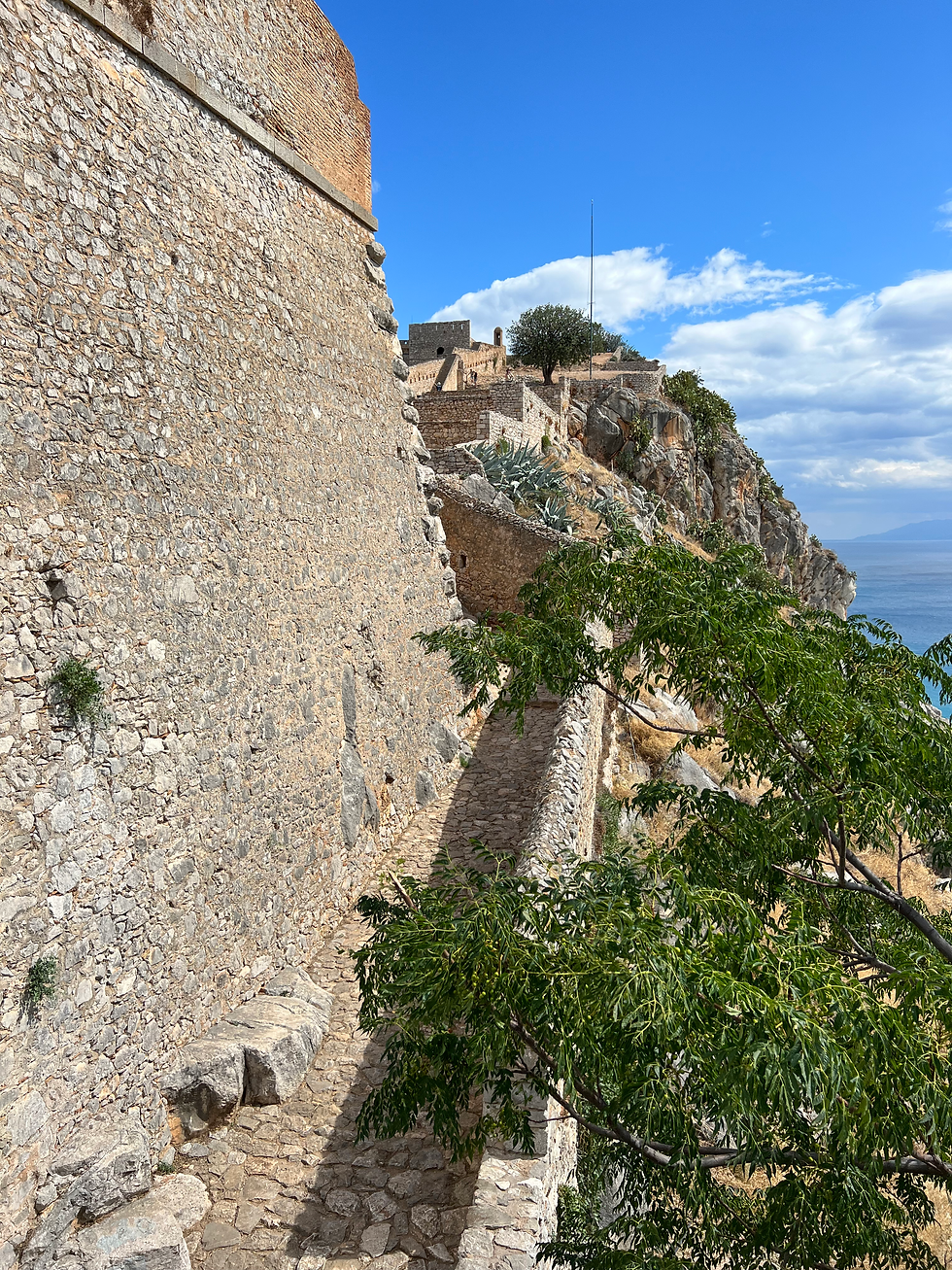F + 21: A Storm is Brewing - Nafplio
- hbanziger
- Sep 5, 2022
- 4 min read
Last night, we anchored in a bay at the northern tip of Spetses. The island is nowadays know as a place for the rich and famous. Indeed, many wealthy Athenians keep beautiful holiday homes on the island. It takes only 2 hours and 20 minutes by speed boat to travel to Spetses. By helicopter it takes a little less - of course.

The Queen of Datca at anchor in one of the many Bays of Spetses
For most Greeks though, Spetses has a different meaning. Exactly 200 years ago, on the 8th of September 1822, a small fleet of Greek vessels defeated a much larger Ottoman naval force. The 56 Greek vessels where merchant and pirate ships. The professional Ottoman fleet consisted of 84 vessels. Greek Admiral Andreas Vokos Miaoulis knew that he was completely outgunned, A frontal attack was out of question. But the Greek remembered the lessons of the Battle of Cesme in 1770 when a small Russian fleet destroyed a superior Ottoman naval force by using fireships. And that is what Admiral Miaoulis set out to do.

The Battle of Spetses was far less intense than this painting suggests - it was not a closely fought action but an ambush of the small Greek Navy with fireships
The winds though did not favour his plan. His fireships only set a small Turkish brig ablaze. But the Turkish Admiral Mohammed Ali got scared and pulled back. After September 8, the Ottoman fleet tried a few more times but by the 13th of September, they withdrew. Admiral Ali did not want to risk more ships. From a tactical perspective, the encounter was a draw. But strategically, the Greek had won a major victory. The superior Ottoman Navy withdrew from the waters around the Peloponnese, the heart of the Greek independent movement.

The Armata Festival takes place in Spetses every year on the 8th of September
To this day, the Battle on 8 September is commemorated every year with the Armata Festival. When all lights are off, a replica of the Ottoman flagship is set alight, blown up and then sunk. The party continues all night and ends with a big firework. Never mind that the Ottoman flagship never was set on fire - why letting such footnotes spoil the patriotic enthusiasm?
Together with the Battle of Dervenakia in July 1822, the Battle of Spetses stands for the turn around in the Greek War of Independence. 1821 was a terrible year with only defeats and heavy losses for the Greek. But after 1822, the Greek Nationalists had an army they could count on, a navy that could stand up against the Ottomans and Nafplio, their first capital.

The Venetian Fortress of Palamidi still towers over Nafplio and is a big Tourist Attraction
One of the direct consequences of the Battle of Spetses was the surrender of the Fortress of Palamidi in December 1822. Not being supplied for months, the Turkish garrison had to raise the white flag. For the first time, the Greek fighters controlled a well fortified town they could make their capital.

The Water Spout approaches us with amazing Speed
Sailing from Spetses to Nafplio this morning was a bit rough. But compared to wind and waves in the Aegean it was a piece of cake - we were so happy to have sailed west yesterday. We reached Nafplio in just three hours. The weather had changed indeed. On our way we encountered a water spout! There are less than 160 sightings a year in Europe. It moves at a speed of 10 - 15 knots/h and is rather violent. We were glad when it dissipated at a safe distance. It was amazing to watch though.

More and more Ships were looking for a safe Place to stay in Nafplio Harbour
We were not the only vessel that had the idea of sitting out tomorrow's storm in a safe harbour. Nafplio's port filled quickly with all sorts of boats. A local said with a smile "feels like Monaco today!" For tomorrow, weather forecast predicts windspeed of 40 knots and higher. Better safe than sorry. We will use the day to visit the splendid theatre of Epidayuros in the morning and Mycenae and King Agamemnon's tomb in the afternoon.

The spectacular View from the Palamidi Fortress on Nafplio
We could not resist the temptation to climb up to the Palamidi Castle. It towers 216 meters above Nafplio and takes 846 steps to climb. But we were rewarded with a beautiful view. The Venetians knew why they built it in 1711 - 1715. It protects the town very well. I won't tell the story of Nafplio on this page. Wikipedia does a better job. Venice got Nafplio back in 1685 during the 6th Venetian-Ottoman War. And lost it again in the 7th. The Turks got a modern, Vauban style fortress for free. Apparently, the French Engineer Pierre de la Salle, who designed and built it, had given them the secret plans. The Palamidi Fortress was also only lightly garrisoned when the Turks attacked. They did not have to make a major effort.

Fort Palamidi is well designed with overlapping
Bastions and multiple Lines of Defence
Nafplio played again an important role in 1822. The control of the Fortress allowed the Greek Nationalist to formally declare Nafplio as their first capital. The Greek Independence Movement now had a place to meet and run the war. It could now also govern the territories it had liberated. In 1822, a storm started brewing here which ended in 1831 with the formal Declaration of Independence and recognition of Greece as an independent Kingdom.

The Entry of the new Greek King, Otto from Bavaria, into Nafplio in 1831







Comments